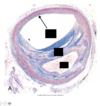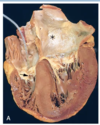Hypertensive & Atherosclerotic CV Disease Flashcards
What are the functions of the normal vascular endothelium in the resting/basal state?
- maintain a permeability barrier
- provide a non-thrombogenic surface
- elaboration of mediators for hemostasis
- produce extracellular matriz
- modulate medial smooth muscle tone
- regulate inflammtion, immunity
- regulate cell growth
- metabolize some hormones (angiotensin)
- oxidize LDL
What happens when you have some kind or injury/stimulus to the endothelium?
- Activated State
- increased expression of procoagulants, adhesion molecules & proinflammatory factors
- altered expression of chemokines, cytokines, and growth factors
What situations can lead to injury/stimulate the endothelial cells to the activated state?
- turbulent flow
- hypertension
- cytokines
- complememt
- bacterial products
- lipid products
- advanced glycation end-products
- hypoxia, acidosis
- viruses
- cigarette smoke
What is the general response of the vascular wall to injury?
intimal thickening
recruitment of smooth muscles cells into the intima where they will proliferate (SM in the media will not be proliferating)
also end up recruiting macrophages & inflammatory cells into the intima as well
leads to deposition of lipids & elaboration of extracellular matrix
What blood pressure levels are considered:
normal
elevated
stage I
stage II
hypertensive crisis
- normal
- less than 120/80 mmHg
- elevated
- systolic between 120-129 mmHg
- diastolic less than 80 mmHg
- stage I
- systolic between 130-139 mmHg
- diastolic between 80-19 mmHg
- stage II
- systolic at least 140 mmHg OR
- diastolic at least 90 mmHg
- hypertensive crisis
- systolic over 180 mmHg and/or diastolic over 120 mmHg
What is the equation for blood pressure?
BP = CO x PVR
What factors directly influence cardiac output?
- Blood volume
- sodium
- mineralcorticoids
- atrial natruietic peptide
- Cardiac Factors
- heart rate
- contractility
What facrots directly impact peripheral resistance?
- Humoral factors
- constrictors
- angiotensin II
- catecholamines
- thromboxanes
- leukotrienes
- endothelin
- dilators
- prostaglandins
- kinins
- NO
- constrictors
- Neural factors
- constriction
- alpha-adrenergic
- dilators
- beta-adrenergic
- constriction
- Local factors
- autoregulation pH
- hypoxia
Check this out! Will be helpful to understand the pathologies

What are the two major types of hypertension? Which is most common?
- Essential hypertension (90-95%)
- Secondary hypertension
- renal
- endocrine
- cardiovascular
- neurologic
What factors are known to play a role in essential hypertension?
Have any specific factors been identified?
- Factors known to play a role
- genetic factors
- reduced renal sodium in the setting of normal arterial pressure
- vasoconstrictive influences
- increased peripheral resistance
- environental factors
- stress
- obesity
- smoking
- high salt intake
- inactivity
- No specific triggers are known
What hypertensive vascular diseases affect large to medium arteries?
Arteries larger than arterioles?
Small arteries / arterioles?
- Large to medium arteries
- degernative vascular wall changes
- accelerate atherogenesis
- Arteries larger than arterioles
- fibromuscular intimal hyperplasia
- Small arteries / arterioles (arteriolosclerosis)
- hyaline arteriolosclerosis
What pathology is shown in the provided image?
Describe the features of the vessel & in what conditions this pathology occurs.

Hyaline arteriolosclerosis
Thickened arteriolar wall with increased plasma protein deposition and narrowed luman
very homogenously pink
Congo red stain will be negative
occurs in chronic hypertension & diabetes mellitus
What pathology is shown in the provided image?
Describe the features of the vessel & in what conditions this pathology occurs.

Hyperplastic arteriolosclerosis
“onion-skinning” causes luminal obliteration. Laminations are composed of smooth muscle cells with reduplicated, thickened baement membranes
occurs in severe (malignant hypertension) – usually have a history of chronic hypertension
What pathology is shown in the provided image?

Monckeberg Medial Calcific Sclerosis
notice calcium deposits centered on internal elastic lamina in the muscularis (dark purple at top of image)
calcium deposits: agranular, amorphous, plate-like deposition
very rarely encroacing on the lumen
What is Monckeberg Medial Calcific Sclerosis?
It is most common in what demographics?
- calcium deposits centered on internal elastic lamina in the muscularis of medium-sized muscular arteries
- not usually severe enough to significantly narrow the lumen
- Demographics
- post-menopausal women
- can sometimes show up on mammograms but ahve to be fairly numerous

Describe the the process of atherosclerosis
- Smooth muscle cells become activated & migrate into the intima from the muscularis
- precursors to the smooth muscles can also be recruited to enter the intima when they will differentiate into smooth muscle cells & proliferate
- deposition of extracellular matrix in the intima
- deposition of extracellular lipids in the intima
- may have some necrotic & inflammatory cells – get recruitment of inflammatory cells
- macrophages (envibing lipids & will have foamy appearance) & lymphocytes

What conditions can lead to atherosclerosis?
How long can this take to develop?
- Conditions
- hyperlipidemia
- hypertension
- smoking
- toxins
- hemodynamic factors
- immune reactions
- viruses
- years to decades to develop
What pathology is shownin the provided image?

Fatty streak
one of the first signs of atherosclerosis
What pathology is show in the provided image?

Intimal Foam Cells
early intimal thickening, don’t really see muscle cells – very subtle
Atherosclerosis






















